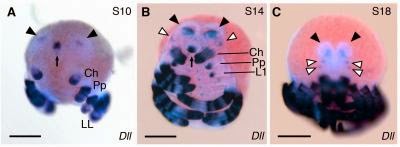
305-million-year-old fossil indicates that primitive harvestmen had extra set of eyesLiving harvestmen—a group of arachnids more commonly known as daddy longlegs—have a single pair of eyes that help them navigate habitats in every continent except Antarctica. But a newly described 305-million-year-old fossil found in eastern France shows that wasn’t always the case. New research recently published in the journal Current Biology and led by scientists at the American Museum of Natural History and the University of Manchester indicates that primitive harvestmen had two pairs of eyes, adding significant details to the evolutionary story of this diverse and highly successful group.
“Terrestrial arthropods like harvestmen have a sparse fossil record because their exoskeletons don’t preserve well,” said Prashant Sharma, a postdoctoral researcher in the Museum’s Division of Invertebrate Zoology and one of the lead authors on the new study. “As a result, some fundamental questions in the evolutionary history of these organisms remain unresolved. This exceptional fossil has given us a rare and detailed look at the anatomy of harvestmen that lived hundreds of millions of years ago.”
Despite having eight long legs and being classified as arachnids, harvestmen are not spiders, even though they resemble them. Instead, they are more closely related to scorpions among the arachnids, a group that also includes mites and ticks. Arachnids can have two kinds of eyes: lateral, those on the side of the body; and median, those near the middle of the body. The former are lacking in harvestmen species living today.
But Hastocularis argus, the new species described by the researchers from the fossil, has both median and lateral eyes. The unique fossil’s anatomy was studied in meticulous detail using high-resolution x-ray imaging at the Natural History Museum, London.
“Fossils preserved in three dimensions are quite rare,” said Russell Garwood, a research fellow at the University of Manchester and a lead author on the study. “This is especially true of harvestmen. Our x-ray techniques have allowed us to reveal this fossil in more detail than we would have dreamed possible two decades ago.”
The researchers corroborated their results by looking at the expression of a particular “eye-stalk-growing” gene in a living species of harvestmen. They found that developing embryos briefly express this gene in the lateral area, where the second eye pair is located in the fossil. But by the time they hatch, harvestmen only form the median eyes.
Note : The above story is based on materials provided by American Museum of Natural History










